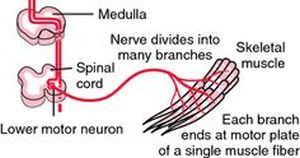

MedFriendly®


Lower Motor Neuron
A lower motor neuron (often abbreviated LMNs) is the
part of a motor neuron (a type of nerve cell) that
connects the brainstem and spinal cord (via the upper
motor neurons) to the skeletal muscles. The brainstem
is an area in the lower part of the brain that connects it
with the spinal cord.
FEATURED BOOK: Principles of Neurology by Adams and Victor
Skeletal muscles are muscles that are connected at either or both arms or legs with the
skeleton of the body. Upper motor neurons are nerve cells in the motor cortex (an area of
the brain located in middle, top part of the brain) that help make up nerve paths within the
brain and from the brain to the spine.
Lower motor neurons are present in the spinal nerves, peripheral nerves (nerves outside
of the brain or spinal cord), and anterior horn cells. Anterior horn cells are types of cells
located in the spinal cord.
Damage to lower motor neurons can cause lower motor neuron paralysis, in which loss of
movement/and or sensation can occur in addition to a loss of certain reflexes and the
occurrence of various other signs and symptoms such as decreased muscle tone,
weakness, fasciculations (small involuntary muscle contraction), decreased reflexes, and
muscle atrophy.
"Where Medical Information is Easy to Understand"™















